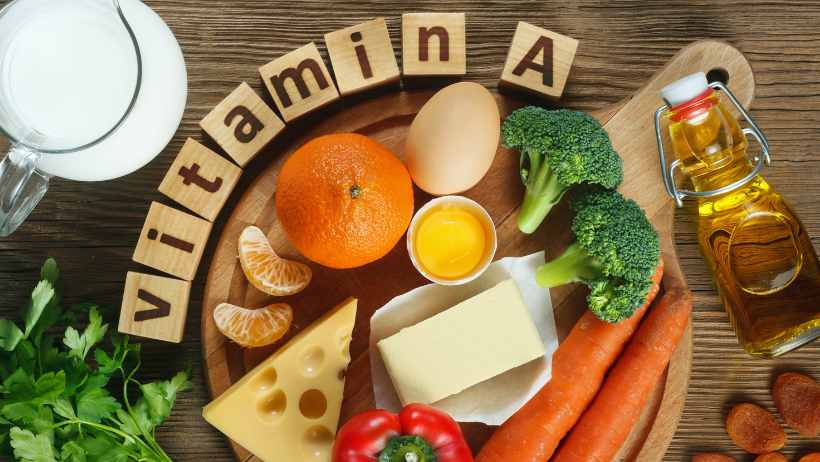
It is vital to keep in mind the significance of vitamin A for immunity and vision in order to maintain optimal health. Vitamin A, which is fat-soluble, is essential for numerous physiological processes, including immune system activity, cell proliferation, and bone development.
Preformed vitamin A, which is present in animal products, and provitamin A, which is found in plant diets, are its two forms. To optimize the consumption of vitamin A, it is advantageous to incorporate a diverse range of foods into one’s dietary regimen. Excellent sources include organ meats, eggs, fish, dairy products, fortified foods, legumes, fruits, and vegetables.
Nevertheless, for optimal absorption, vitamin A-rich foods should be consumed in conjunction with dietary lipids. It is essential to adhere to the prescribed dietary allowance of 900 micrograms RAE for males and 700 micrograms RAE for females in order to sustain optimal vitamin A levels.
By incorporating all dietary groups into a balanced diet, one can satisfy their vitamin A requirements and promote overall health.
Regarding Vision
Vitamin A’s significance for vision
Vitamin A is essential for proper vision maintenance. It is essential for the proper operation of the retina, the eye tissue responsible for converting light into comprehensible electrical signals for the brain. Inadequate levels of vitamin A could potentially impede the efficient transmission of these signals, resulting in visual impairment.
The function of vitamin A in preserving eye health
Besides its contribution to vision, vitamin A enhances the overall health of the eyes. It aids in maintaining a moist and healthy eye surface, thereby reducing the risk of eye infections and irritation. Additionally, tear production is stimulated by vitamin A, which is vital for lubricating the eye and preserving clear vision. Deficiency in vitamin A can lead to ocular dryness and increased vulnerability to infections, ultimately compromising eye function.
Immune protection
Criticality of vitamin A to the immune system
Vitamin A is essential for the maintenance of a robust immune system. It facilitates the regulation of immune cell production and activity, including that of white blood cells, the primary barrier against infections within the body. Additionally, vitamin A facilitates the synthesis of antibodies, which aid in the detection and eradication of pathogenic microorganisms.
The function of vitamin A in bolstering immune systems
Vitamin A is implicated in numerous facets of the immune system. It aids in the preservation of epithelial membrane integrity, which serves as an impregnatory barrier against detrimental pathogens. Vitamin A is additionally implicated in the formation and operation of immune cells, including T cells and B cells, which are tasked with the identification and eradication of foreign pathogens. Vitamin A also possesses anti-inflammatory properties that may aid in mitigating the severity of specific immune-related disorders.
Varieties of Vitamin A
Vitaformed preformed A
Retinol, which is preformed vitamin A, is present in animal products. It is an immediately usable form of vitamin A that is readily assimilated by the body. Particularly profuse in preformed vitamin A are foods like liver, fish, and dairy products.
A provitamin
Carotenoids, which include provitamin A, are present in plant-based diets. It is a vitamin A derivative that the body converts to retinol. Beta-carotene, the preeminent provitamin A carotenoid, is predominantly present in fruits and vegetables, including carrots, sweet potatoes, and spinach.
Vitamin A sources include animal products.
Animal products contain an exceptional amount of vitamin A. They consist of preformed vitamin A, which is physiologically accessible for utilization by the body. Several animal products and organ meats, eggs, rich fish, and dairy products are excellent sources of vitamin A.
Plant-based cuisine
Vitamin A is present in plant diets as well, albeit in the form of provitamin A carotenoids. Although the body is responsible for converting these carotenoids into retinol, they can still serve as a source of vitamin A. Vitamin A-rich plant foods consist of legumes, fruits, and vegetables.
Animal-Based Items
Embryo preparations
Liver and other organ meats are among the most abundant sources of vitamin A. A minute portion of liver can supply multiple times the daily allowance of vitamin A. Nevertheless, it is critical to acknowledge that organ meats contain a significant amount of saturated fat, thus they should be consumed sparingly.
Eggs
Eggs also provide an excellent source of vitamin A. This vital vitamin is present in the egg yolk, in addition to various other significant nutrients. Furthermore, eggs supply additional health benefits, including protein and omega-3 fatty acids, in addition to aiding in the supplementation of vitamin A.
Oily seafood
Fatty fish, including salmon and mackerel, are vitamin A-rich in addition to being an excellent source of healthful omega-3 fatty acids. In addition to being an excellent addition to a balanced diet, these fish contain both nutrients that are vital to good health.
Produced dairy
Frequently, dairy products like cheese and milk are fortified with vitamin A. As a consequence, producers supplement these goods with vitamin A in order to elevate their nutritional content. Dairy products can serve as a convenient means of guaranteeing a sufficient consumption of this vital vitamin.
Food plants Legumes
Legumes, including black-eyed peas, are a source of vitamin A. Although their concentration may not be as pronounced as that of animal sources, these foods still hold significant value within a plant-based diet. Legumes also provide fiber, protein, and additional advantageous nutrients derived from plants.
Fruits Provitamin A carotenoids are abundant in numerous fruits, especially those that are yellow or orange in hue. Such fruits consist of carrots, mangoes, and cantaloupes, as examples. Including an assortment of fruits in your diet can assist in guaranteeing adequate vitamin A consumption.
Produced vegetables
Vegetables, similar to fruits, can serve as valuable reservoirs of provitamin A carotenoids. Dark leafy greens, including kale and spinach, contain an abundance of these carotenoids. Consuming a vibrant assemblage of vegetables not only contributes to the acquisition of vitamin A, but also furnishes an extensive array of additional vitamins and minerals.
Enhancing Absorption
Combining foods high in vitamin A with dietary fat
Vitamin A is fat-soluble, meaning that it is assimilated most efficiently when combined with dietary fat. By supplementing vitamin A-rich foods with healthy fats like avocado or olive oil, the absorption of this vital nutrient can be improved.
Aspects influencing vitamin A absorption
There are numerous variables that can influence vitamin A absorption. These encompass specific gastrointestinal disorders, such as Crohn’s disease and celiac disease, that have the potential to hinder the assimilation of nutrients. Furthermore, the ingestion of excessive quantities of alcohol or specific medications might impede the body’s capacity to assimilate and employ vitamin A.
Appropriate Dietary Allowance
Males aged 19 and older RDA
Vitamin A’s recommended dietary allowance (RDA) differs between gender and age. The daily RDA for males aged 19 and older is 900 micrograms RAE (Retinol Activity Equivalents). This value considers the conversion of provitamin A carotenoids into retinol as well as preformed vitamin A.
RDA for women aged 19 or older
Vitamin A RDAs for females aged 19 and older are marginally lower than those for males. The daily dosage is 700 micrograms of RAE. The purpose of this recommendation is to promote the overall health and wellness of adult women.
Preserving Optimal Levels
The significance of ingesting vitamin A-rich meals
Although the majority of Americans obtain sufficient vitamin A from their daily diets, it remains critical to incorporate foods that are rich in this vital nutrient. This is particularly true for individuals with restricted access to a variety of nutrients or those who have elevated vitamin A needs. You can help ensure that you have adequate levels of this vital vitamin by incorporating vitamin A-rich foods into your diet.
Achieving adequate levels of vitamin A
It is crucial to maintain adequate levels of vitamin A by incorporating a balanced and varied diet that comprises plant and animal sources of this vital nutrient. To fulfil one’s vitamin A requirements, it is advisable to include liver, eggs, fish, legumes, fruits, and vegetables in their meal preparations. In order to ensure adequate vitamin A intake in the presence of specific dietary restrictions or limitations, it may be advantageous to seek guidance from a registered dietitian or healthcare professional.
The Critical Role of a Well-Rounded Diet
Appropriate vitamin A intake
Despite the fact that vitamin A is essential for numerous physiological processes, it is essential to keep in mind that it is only one component of a balanced diet. A diverse array of essential nutrients, in addition to vitamin A, can be obtained through the consumption of foods from all food groups.
The health advantages of a balanced diet as a whole
A well-rounded dietary regimen encompassing all food groups not only fulfills the requirement for vitamin A but also imparts an abundance of other health advantages. It promotes overall wellbeing, aids in the maintenance of a healthy weight, and decreases the risk of chronic diseases including type 2 diabetes and cardiovascular disease. One can experience the manifold advantages of a balanced diet while simultaneously guaranteeing sufficient consumption of vital nutrients such as vitamin A.
Vitamin A is, in conclusion, an indispensable nutrient that is fundamental to immunity, vision, and overall health. Vitamin A, in its preformed form, is predominantly present in animal products, whereas provitamin A carotenoids are predominantly found in plant diets. A variety of these vitamin A-rich foods can be incorporated into a well-balanced diet in order to help maintain optimal levels of this essential nutrient. Additionally, vitamin A-rich foods that are paired with dietary fat can improve absorption. By adhering to the prescribed dietary allowance and assuring sufficient consumption of vitamin A, one can promote optimal vision, immunity, and overall well-being.










